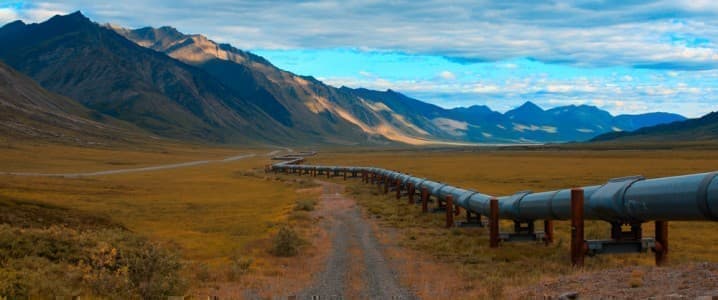The fossil fuel industry has received plenty of flak over the past decade for its conspicuous role in climate change. The usual script goes something like this: Fossil fuels - which currently supply 80 percent of the world’s energy needs - release large amounts of CO2, a greenhouse gas, into the atmosphere when burned. CO2 traps large amounts of heat in our atmosphere, directly contributing to global warming and climate change. But now a new script has emerged: Leaky oil and gas infrastructure has been playing an outsized role in climate change by spewing out far more quantities of an even more potent greenhouse gas into the atmosphere than earlier thought.
Reuters has reported that satellites by the European Space Agency have detected huge plumes of methane leaking from the 2,607-mile-long Yamal pipeline that transports natural gas from Siberia to Europe.
The massive methane leaks could throw a monkey wrench into the natural gas bridge, which presupposes that natural gas is a cleaner fossil fuel causing it to be favored over coal in the global energy mix.
Methane leaks

Source: Reuters
Using the satellite data, energy consultancy Kayrros has estimated that one leak was spewing out a staggering 93 tonnes of methane every hour, equal to the amount of CO2 emitted by 15,000 cars in the U.S. in a whole year. A second leak on the same pipeline was nearly as egregious, gushing 17 tonnes of the colorless and odorless gas every hour.
Gazprom, the operator of the giant pipeline, has not responded to requests for comments by Kayrros.
The latest discoveries suggest that we have been unfairly blaming mud volcanoes and natural oil and gas seepages for the sharp increase in atmospheric methane and that our drilling activities could, in fact, be directly responsible.
Related: A Look At Europe’s Ambitious $140 Billion Hydrogen Plan Currently, there isn’t much methane in the atmosphere - only 1,870 parts per billion, or about two cups of water inside a standard Olympic-size swimming pool. In contrast, CO2 levels in 2018 were measured at 407.4 parts per million (ppm), making it 226.3x more abundant than methane in the atmosphere. Although methane does not usually get the same bad rap that carbon dioxide does, it’s actually a far more potent greenhouse gas, more than 80x more powerful at warming the earth than CO2 over 20 years and 28x more powerful on a 100-year timescale. Methane’s chemical shape makes it remarkably effective at trapping heat, and adding just a little more of the gas into the atmosphere can have profound effects on how quickly the planet warms.
The bad news: Methane levels have increased sharply over the past four decades and are now responsible for about one-sixth of the total energy imbalance that is causing global warming.

Source: Climate.gov
Oil and gas companies in the spotlight
Methane typically lasts only about a decade before it’s cycled out - a blip compared to the centuries that a CO2 molecule can last. However, methane has many sources meaning the atmospheric load is constantly regenerated.
About 40 percent of the earth’s methane is thought to come from natural sources, including wetlands and bogs. Many microbes that thrive in oxygen-deprived ecosystems like waterlogged wetland soils spew out methane instead of CO2, which leaks directly into the atmosphere. Some methane also seeps out of the ground in areas with high volcanic activity as well as naturally near some oil and gas deposits.
Human activities, however, are by far the biggest source of methane on our planet, contributing 60 percent of new emissions every year. Our 1.4 billion or so domesticated bovines, as well as oil and gas drilling activities, are responsible for much of the damage.
Cows and other grazing animals host trillions of gut-filling hitchhikers that help them break down tough grasses to access the nutrients. These anaerobic microbes account for about a quarter of the world’s annual methane budget. Other agricultural endeavors such as rice paddies, landfills, and sewage treatment centers also produce significant amounts of methane. Related: 3 Oil Stocks With Good Upside And 3 To Avoid
It was previously estimated that the energy sector contributes ~25 percent of the world’s methane emissions. However, the latest revelation implies that these estimates are highly conservative.
Indeed, the latest findings are backed by a 2015 study that found that U.S. oil and gas supply chains produce ∼60 percent more methane than estimates by the Environmental Protection Agency (EPA).
Hitherto, most industries have estimated greenhouse gas emission by largely relying on paper-based calculations of what’s pouring out of smokestacks and tailpipes, as well as based on the amount of energy consumed by end-users. But improvements in satellite technology are allowing researchers to actually stress test the data - and so far, it’s revealing that oil and gas companies are more culpable than we thought.
Many countries have enacted strict rules about how much methane leakage is allowed. Unfortunately, these rules have mostly proven difficult to enforce. The latest revelation is likely to heap additional pressure on embattled energy companies to track their methane emissions and plug them.
BP and Royal Dutch Shell have invested in satellite companies or signed monitoring deals to help track and plug their methane leaks - this might soon become mandatory for all oil and gas companies involved in drilling and transportation activities.
By Alex Kimani for Oilprice.com
More Top Reads From Oilprice.com:
- Supermajors Are Flocking To This Booming Oil Frontier
- Big Oil’s Nightmare Is Coming True
- Turning California’s Biggest Liability Into A Biofuel Boom



















Instead, it's so much easier to ignore and deny. We do not see the leaks except by special means. This issue of large-scale methane pollution will catch up to us, and it's gonna hurt.